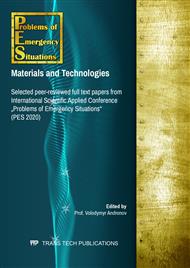[1]
V.I. Antonenko, A.A. Vasil'ev, I.M. Olihov, Rannee obnaruzhenie pozhara. Poluprovodnikovye gazovye sensory. [in Russian]. daily.sec.ru/dailypblshow.cfm?rid=6&pid=5603.
Google Scholar
[2]
A.L. Gusev, I. V. Zolotuhin, YU. E. Kalinin, A. V. Sitnikov, Datchiki vodoroda i vodorodsoderzhashchih molekul, Vodorodnaya energetika. 5 (2005) 23-31 [in Russian].
Google Scholar
[3]
C. Sandaruwan, H.M.P.C.K. Herath, T.S.E.F. Karunarathne et al., Polyaniline/palladium nanohybrids for moisture and hydrogen detection, Chemistry Central Journal. 12 (2018) 93.
DOI: 10.1186/s13065-018-0461-y
Google Scholar
[4]
H. Bai, G. Shi, Gas sensors based on conducting polymers. Sensors. 7 (2007) 267-307.
DOI: 10.3390/s7030267
Google Scholar
[5]
Yuan Gao, Chien-An Chen, Han-Mou Gau, James A. Bailey, Elshan Akhadov, Darrick Williams, Hsing-Lin Wang, Facile Synthesis of Polyaniline-Supported Pd Nanoparticles and Their Catalytic Properties toward Selective Hydrogenation of Alkynes and Cinnamaldehyde, Chem. Mater. 20(8) (2008) 2839-2844. ACS Publications.
DOI: 10.1021/cm7030416
Google Scholar
[6]
N.J. Pinto, Electrospun conducting polymer nanofibers as the active material in sensors and diodes. J. Phys. Conf. Ser. 421 (2013) 1–6.
DOI: 10.1088/1742-6596/421/1/012004
Google Scholar
[7]
A. MacAgnano, E. Zampetti, S. Pantalei et al., Nanofibrous PANI-based conductive polymers for trace gas analysis, Thin Solid Films. 520 (2011) 978–85.
DOI: 10.1016/j.tsf.2011.04.175
Google Scholar
[8]
B.І. Bajrachnij, L.V. Lyashok, І.O. Afonіna, T.V. Orєhova, V.O. CHeranovs'kij, Іmmobіlіzacіya nanochastok Pd v polіmernu matricyu, Vіsnik NTU HPI,. 30 (2010) 57-61 [in Ukrainian].
Google Scholar
[9]
M. Kent, Kost. Duane, E. Bartak, Beth. Kazee, Theodore Kuwana, Electrodeposition of platinum microparticles into polyaniline films with electrocatalytic applications, Anal. Chem. 60 (21) (1988) 2379-2384. ACS Publications.
DOI: 10.1021/ac00172a012
Google Scholar
[10]
A.J. Burris, K. Tran, Q. Cheng, Tunable Enhancement of a Graphene/Polyaniline/Poly(ethylene oxide) Composite Electrospun Nanofiber Gas Sensor, J. Anal. Test. 1 (2017) 12.
DOI: 10.1007/s41664-017-0012-x
Google Scholar
[11]
B.I. Podlovchenko, V.N. Andreev, Elektrokataliz na modificirovannyh polimerami elektrodah, Uspekhi himii. 71(10) (2002) 950–965 [in Russian].
Google Scholar
[12]
V.N. Andreev, M.A. Spicyn, V.E. Kazarinov, Adsorbcionnye i elektrokataliticheskie svojstva steklouglerodnyh elektrodov, modificirovannyh plenkami polianilina i chasticami osazhdennoj platiny, Elektrohimiya. 32(12) (1996) 1417−1423 [in Russian].
Google Scholar
[13]
B.I. Bairachnyi, A.V. Vasil'chenko, L.V. Lyashok, T.V. Orekhova, T.F. Baikova,.Synthesis of polyaniline films on graphitized butyl rubber, Russian journal of applied chemistry; 72 (5) (1999) 883-885.
Google Scholar
[14]
B.I. Bairachnyi, A.V. Vasil'chenko, L.V. Lyashok, T.V. Orekhova, T.F. Baikova,.Polyaniline Cathode in Secondary Storage Batteries, Russian journal of applied chemistry. 72 (2) (1999) 225-228.
Google Scholar
[15]
L. Li, G. Yan, J. Wu et al., Preparation of polyaniline–palladium composite microflakes by one-step interface polymerization method, J Polym Res. 16 (2009) 421–426.
DOI: 10.1007/s10965-008-9244-9
Google Scholar
[16]
Gertrude Fomo, Tesfaye T. Waryo, Priscilla Baker, Emmanuel I. Iwuoha, Electrochemical Deposition and Properties of Polyaniline Films on Carbon and Precious Metal Surfaces in Perchloric Acid/ Acetonitrile, Int. J. Electrochem. Sci. 11 (2016) 10347–10361.
DOI: 10.20964/2016.12.102
Google Scholar
[17]
V.N. Andreev, V.I. Zolotarevskii, Structure and properties of the Nafion–polyaniline–palladium composite electrodes, Russ J Electrochem. 41 (2005) 189–194.
DOI: 10.1007/s11175-005-0031-1
Google Scholar
[18]
WadiaDhaoui, MagdalenaHasik, DavidDjurado, AndrzejBernasik, AdamPron, Redox behaviour of polyaniline–palladium catalytic system in the presence of formic acid, Synthetic Metals. 160(23–24) (2010) 2546-2551.
DOI: 10.1016/j.synthmet.2010.10.003
Google Scholar
[19]
X. Tang, P. Haddad, N. Mager et al. Chemically deposited palladium nanoparticles on graphene for hydrogen sensor applications, Sci. Rep. 9 (2019) 3653.
DOI: 10.1038/s41598-019-40257-7
Google Scholar


